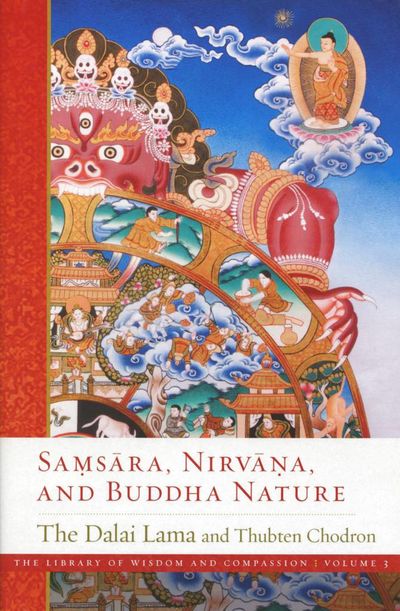No edit summary |
No edit summary |
||
| Line 1: | Line 1: | ||
{{Book | {{Book | ||
|TileDescription=This is the third volume in the Dalai Lama’s definitive and comprehensive series on the stages of the Buddhist path. | |||
|BookPerson={{Book-person | |BookPerson={{Book-person | ||
|PersonPage=Chodron, T. | |PersonPage=Chodron, T. | ||
| Line 8: | Line 9: | ||
}} | }} | ||
|FullTextRead=No | |FullTextRead=No | ||
|BookToc=* {{i|Preface by | |BookToc=* {{i|Preface by Bhikṣuṇī Thubten Chodron |xiii}} | ||
* {{i|Abbreviations |xxi}} | * {{i|Abbreviations |xxi}} | ||
* {{i|Introduction by His Holiness the Dalai Lama |i}} | * {{i|Introduction by His Holiness the Dalai Lama |i}} | ||
| Line 15: | Line 16: | ||
*** {{i|The Four Truths |10}} | *** {{i|The Four Truths |10}} | ||
*** {{i|The Coarse and Subtle Four Truths |18}} | *** {{i|The Coarse and Subtle Four Truths |18}} | ||
*** {{i|The Sixteen Attributes of the Four Truths of | *** {{i|The Sixteen Attributes of the Four Truths of Āryas |19}} | ||
** {{i|2. Revolving in Cyclic Existence: The Truth of | ** {{i|2. Revolving in Cyclic Existence: The Truth of Duḥkha |39}} | ||
*** {{i|Knowing | *** {{i|Knowing Duḥkha for What It Is |39}} | ||
*** {{i|Realms of Existence |41}} | *** {{i|Realms of Existence |41}} | ||
*** {{i|Three Types of | *** {{i|Three Types of Duḥkha |47}} | ||
*** {{i|Feelings, Afflictions, and | *** {{i|Feelings, Afflictions, and Duḥkha |50}} | ||
*** {{i|Six Disadvantages of Cyclic Existence |51}} | *** {{i|Six Disadvantages of Cyclic Existence |51}} | ||
*** {{i|Eight Unsatisfactory Conditions |53}} | *** {{i|Eight Unsatisfactory Conditions |53}} | ||
*** {{i|Examining True | *** {{i|Examining True Duḥkha via Ten Points |54}} | ||
*** {{i|Our Human Value |57}} | *** {{i|Our Human Value |57}} | ||
** {{i|3. True Origins of | ** {{i|3. True Origins of Duḥkha |63}} | ||
*** {{i|The Six Root Afflictions |64}} | *** {{i|The Six Root Afflictions |64}} | ||
*** {{i|More Types ofDefilements |87}} | *** {{i|More Types ofDefilements |87}} | ||
| Line 51: | Line 52: | ||
*** {{i|The Origin of the Universe |141}} | *** {{i|The Origin of the Universe |141}} | ||
*** {{i|Mind and the External World |144}} | *** {{i|Mind and the External World |144}} | ||
*** {{i|The Laws | *** {{i|The Laws of Nature and the Law of Karma and Its Effects |148}} | ||
*** {{i|Karma and Our Present Environment |150}} | *** {{i|Karma and Our Present Environment |150}} | ||
*** {{i|Karma, Instinctual Behavior, and Our Bodies |152}} | *** {{i|Karma, Instinctual Behavior, and Our Bodies |152}} | ||
| Line 57: | Line 58: | ||
*** {{i|Dependent Arising |156}} | *** {{i|Dependent Arising |156}} | ||
*** {{i|How Cyclic Existence Occurs |158}} | *** {{i|How Cyclic Existence Occurs |158}} | ||
*** {{i|1. Ignorance ( | *** {{i|1. Ignorance (''avidyā'') |159}} | ||
*** {{i|2. Formative Action ( | *** {{i|2. Formative Action (''saṃskāra karman'') |165}} | ||
*** {{i|3. Consciousness ( | *** {{i|3. Consciousness (''vijñāna'') |168}} | ||
*** {{i|4. Name and Form ( | *** {{i|4. Name and Form (''nāma-rūpa'') |170}} | ||
*** {{i|3. Six Sources ( | *** {{i|3. Six Sources (''ṣaḍāyatana'') |172}} | ||
*** {{i|6. Contact ( | *** {{i|6. Contact (''sparśa'') |176}} | ||
*** {{i|7. Feeling ( | *** {{i|7. Feeling (''vedanā'')| 176}} | ||
*** {{i|8. Craving ( | *** {{i|8. Craving (''tṛṣṇā'') |179}} | ||
*** {{i|9. Clinging ( | *** {{i|9. Clinging (''upādanā'') |182}} | ||
*** {{i|10. Renewed Existence (bhava) |183}} | *** {{i|10. Renewed Existence (''bhava'') |183}} | ||
*** {{i|11. Birth ( | *** {{i|11. Birth (''jāti'') |188}} | ||
*** {{i|12. Aging or Death ( | *** {{i|12. Aging or Death (''jarāmaraṇa'') |190}} | ||
** {{i|8. Dependent Origination: Cycling in | ** {{i|8. Dependent Origination: Cycling in Saṃsāra |193}} | ||
*** {{i|How the Twelve Links Produce a Life |193}} | *** {{i|How the Twelve Links Produce a Life |193}} | ||
*** {{i|An Example |197}} | *** {{i|An Example |197}} | ||
*** {{i|Flexibility |200}} | *** {{i|Flexibility |200}} | ||
*** {{i|Pali Tradition: How We Cycle |200}} | *** {{i|Pali Tradition: How We Cycle |200}} | ||
*** {{i|An Example from a | *** {{i|An Example from a Pāli Sūtra |202}} | ||
*** {{i|Who Revolves in Cyclic Existence? |204}} | *** {{i|Who Revolves in Cyclic Existence? |204}} | ||
*** {{i|The Ultimate Nature of the Twelve Links |211}} | *** {{i|The Ultimate Nature of the Twelve Links |211}} | ||
** {{i|9. The Determination to Be Free |217}} | ** {{i|9. The Determination to Be Free |217}} | ||
*** {{i|The Benefits | *** {{i|The Benefits of Meditating on the Twelve Links |217}} | ||
*** {{i|Invigorating a Dry Dharma Practice |219}} | *** {{i|Invigorating a Dry Dharma Practice |219}} | ||
*** {{i|Can a Leper Find Happiness? |222}} | *** {{i|Can a Leper Find Happiness? |222}} | ||
| Line 84: | Line 85: | ||
*** {{i|The Demarcation of Generating the Determination to Be Free |227}} | *** {{i|The Demarcation of Generating the Determination to Be Free |227}} | ||
** {{i|10. Seeking Genuine Peace |231}} | ** {{i|10. Seeking Genuine Peace |231}} | ||
*** {{i|The "Ye | *** {{i|The "Ye Dharmā" Dhāraṇī |232}} | ||
*** {{i|Forward and Reverse Orders of the Afflictive and Purified Sides of the Twelve Links |234}} | *** {{i|Forward and Reverse Orders of the Afflictive and Purified Sides of the Twelve Links |234}} | ||
*** {{i|Transcendental Dependent Origination ( | *** {{i|Transcendental Dependent Origination (Pāli Tradition) |238}} | ||
*** {{i|Karma in Samsara and Beyond |249}} | *** {{i|Karma in Samsara and Beyond |249}} | ||
** {{i|11. Freedom from Cyclic Existence |233}} | ** {{i|11. Freedom from Cyclic Existence |233}} | ||
*** {{i|Stages Leading to Liberation and Full Awakening |254}} | *** {{i|Stages Leading to Liberation and Full Awakening |254}} | ||
*** {{i|The Two Obscurations |259}} | *** {{i|The Two Obscurations |259}} | ||
*** {{i| | *** {{i|Nirvāṇa |262}} | ||
*** {{i| | *** {{i|Pāli Tradition: Nirvāṇa |266}} | ||
*** {{i|Bodhi |274}} | *** {{i|Bodhi |274}} | ||
** {{i|12. The Mind and Its Potential |277}} | ** {{i|12. The Mind and Its Potential |277}} | ||
| Line 99: | Line 100: | ||
*** {{i|Excellent Qualities Can Be Cultivated Limitlessly |281}} | *** {{i|Excellent Qualities Can Be Cultivated Limitlessly |281}} | ||
*** {{i|Afflictive Mental States and the Nature of the Mind |283}} | *** {{i|Afflictive Mental States and the Nature of the Mind |283}} | ||
*** {{i|The Equality | *** {{i|The Equality of Saṃsāra and Nirvāṇa |284}} | ||
*** {{i|Levels | *** {{i|Levels of Mind |286}} | ||
** {{i|13. Buddha Nature |291}} | ** {{i|13. Buddha Nature |291}} | ||
*** {{i|The Mind's Potential according to the | *** {{i|The Mind's Potential according to the Pāli Tradition |291}} | ||
*** {{i| | *** {{i|Ārya Disposition according to the Vaibhāṣikas and Sautrāntikas |292}} | ||
*** {{i|Buddha Nature according to the | *** {{i|Buddha Nature according to the Cittamātra School |293}} | ||
*** {{i|Buddha Nature according to the Madhyamaka School |296}} | *** {{i|Buddha Nature according to the Madhyamaka School |296}} | ||
*** {{i|Buddha Nature according to Tantra |301}} | *** {{i|Buddha Nature according to Tantra |301}} | ||
*** {{i|Nine Similes for | *** {{i|Nine Similes for Tathāgatagarbha |302}} | ||
*** {{i|Three Aspects of the | *** {{i|Three Aspects of the Tathāgatagarbha |310}} | ||
*** {{i|Three Aspects ofBuddha Disposition |314}} | *** {{i|Three Aspects ofBuddha Disposition |314}} | ||
*** {{i|A Puzzle |315}} | *** {{i|A Puzzle |315}} | ||
** {{i|14. Going Deeper into Buddha Nature |319}} | ** {{i|14. Going Deeper into Buddha Nature |319}} | ||
*** {{i|The Three Turnings of the Dharma Wheel and Buddha Nature |319}} | *** {{i|The Three Turnings of the Dharma Wheel and Buddha Nature |319}} | ||
*** {{i|A Link between | *** {{i|A Link between Sūtra and Tantra |322}} | ||
*** {{i|Nothing Is to Be Removed |325}} | *** {{i|Nothing Is to Be Removed |325}} | ||
*** {{i|The Capacity Giving Rise to the Three | *** {{i|The Capacity Giving Rise to the Three Kāyas |327}} | ||
*** {{i|A Buddha's Nature | *** {{i|A Buddha's Nature Dharmakāya |328}} | ||
*** {{i|Pristine Wisdom Abiding in the Afflictions |330}} | *** {{i|Pristine Wisdom Abiding in the Afflictions |330}} | ||
*** {{i|Causal Clear Light Mind |332}} | *** {{i|Causal Clear Light Mind |332}} | ||
*** {{i|What Continues to Awakening? |332}} | *** {{i|What Continues to Awakening? |332}} | ||
*** {{i|Dzogchen and | *** {{i|Dzogchen and Mahāmudrā |334}} | ||
*** {{i|Are We Already Buddhas? |337}} | *** {{i|Are We Already Buddhas? |337}} | ||
*** {{i|Awareness of Our Buddha Nature Eliminates Hindrances |341}} | *** {{i|Awareness of Our Buddha Nature Eliminates Hindrances |341}} | ||
Revision as of 09:38, 20 March 2020
Knowledge of buddha nature reveals and reconciles the paradox of how the mind can be the basis for both the duhkha of samsara (the unpurified mind) and the bliss and fulfillment of nirvana (the purified mind). To illustrate this, Saṃsāra, Nirvāṇa, and Buddha Nature first takes readers through Buddhist thought on the self, the four truths, and their sixteen attributes. It then explains afflictions—including how they arise and their antidotes—followed by an examination of karma and cyclic existence, and, finally, a deep and thorough elucidation of buddha nature. Saṃsāra, Nirvāṇa, and Buddha Nature shows us how to purify our minds and cultivate awakened qualities.
This is the third volume in the Dalai Lama’s definitive and comprehensive series on the stages of the Buddhist path, The Library of Wisdom and Compassion. Volume 1, Approaching the Buddhist Path,contains introductory material that sets the context for Buddhist practice. Volume 2, The Foundation of Buddhist Practice, describes the important teachings that help us establish a flourishing Dharma practice. Saṃsāra, Nirvāṇa, and Buddha Nature can be read as the logical next step in this series or enjoyed on its own. (Source: Wisdom Publications)
| Citation | Dalai Lama, 14th, and Thubten Chodron. Saṃsāra, Nirvāṇa, and Buddha Nature. Library of Wisdom and Compassion 3. Somerville, MA: Wisdom Publications, 2018. |
|---|---|


